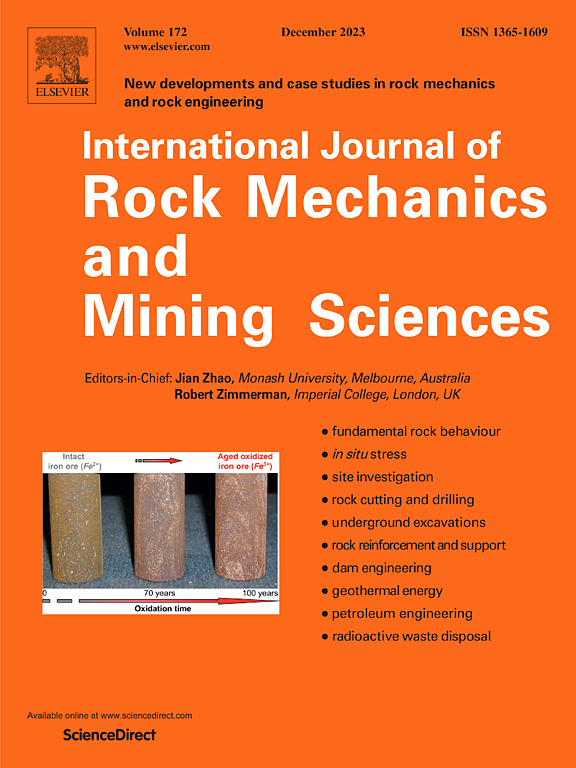Multitask intelligent early warning of rockbursts based on classification-regression cascaded network model
IF 7
1区 工程技术
Q1 ENGINEERING, GEOLOGICAL
International Journal of Rock Mechanics and Mining Sciences
Pub Date : 2025-03-31
DOI:10.1016/j.ijrmms.2025.106103
引用次数: 0
Abstract
With the expansion of underground engineering into deeper levels, the frequency of rockburst disasters has gradually increased, posing serious threats to the safety of construction personnel and equipment. The occurrence of rockbursts typically involves information about time, location, and intensity, which makes it challenging for traditional single‒intelligence prediction methods to capture the multiple characteristics of rockbursts simultaneously and comprehensively. In this study, we established a rockburst prediction dataset that includes temporal information, locational information, construction factors, and microseismic source parameters. The correlation between each parameter was analysed, and the classification‒regression cascaded network model was constructed to provide a multitask early warning method for rockbursts. The method addressed the problem of imbalanced samples with different rockburst intensity grades and achieved multitask early warning for rockburst intensity grade classification, occurrence time, and location. Through comprehensive evaluation, the convolutional neural network - gated recurrent unit (CNN–GRU) and convolutional neural network ‒ feedforward neural network (CNN‒FNN) models outperform the ResNet18–GRU and UNet–GRU models in terms of the prediction of the rockburst intensity grade, occurrence time, and location. Concurrently, a dynamic prevention and control strategy for rockbursts, which involves ‘short‒term prediction to ensure personnel safety and long‒term prediction to adjust support and prevention and control’, was proposed. Finally, the weighting of the influence of each input parameter on the prediction of the rockburst intensity grade, occurrence time, and location was discussed. The findings indicate a high weighting of the combined effect of energy, static stress drop, and ES/EP on rockbursts. This study proposes an innovative and practical method for rockburst prediction, providing theoretical and technical support for early warning and control of rockburst in underground engineering.
基于分类回归级联网络模型的岩爆多任务智能预警
随着地下工程向更深层次的扩展,岩爆灾害的发生频率逐渐增加,对施工人员和设备的安全构成严重威胁。岩爆的发生通常涉及时间、地点和强度等信息,传统的单智能预测方法难以同时、全面地捕捉岩爆的多种特征。在这项研究中,我们建立了一个包括时间信息、位置信息、建筑因素和微震源参数的岩爆预测数据集。分析了各参数之间的相关性,建立了分类回归级联网络模型,为岩爆多任务预警提供了方法。该方法解决了不同岩爆强度等级样本不平衡的问题,实现了岩爆强度等级分类、发生时间和地点的多任务预警。综合评价,卷积神经网络-门控循环单元(CNN-GRU)和卷积神经网络-前馈神经网络(CNN-FNN)模型在预测岩爆烈度等级、发生时间和地点方面优于ResNet18-GRU和UNet-GRU模型。同时,提出了“短期预测确保人员安全,长期预测调整支护和防治”的岩爆动态防治策略。最后,讨论了各输入参数对岩爆强度等级、发生时间和地点预测的影响权重。研究结果表明,能量、静应力降和ES/EP对岩爆的综合影响具有很高的权重。本研究提出了一种创新实用的岩爆预测方法,为地下工程岩爆预警与控制提供理论和技术支持。
本文章由计算机程序翻译,如有差异,请以英文原文为准。
求助全文
约1分钟内获得全文
求助全文
来源期刊
CiteScore
14.00
自引率
5.60%
发文量
196
审稿时长
18 weeks
期刊介绍:
The International Journal of Rock Mechanics and Mining Sciences focuses on original research, new developments, site measurements, and case studies within the fields of rock mechanics and rock engineering. Serving as an international platform, it showcases high-quality papers addressing rock mechanics and the application of its principles and techniques in mining and civil engineering projects situated on or within rock masses. These projects encompass a wide range, including slopes, open-pit mines, quarries, shafts, tunnels, caverns, underground mines, metro systems, dams, hydro-electric stations, geothermal energy, petroleum engineering, and radioactive waste disposal. The journal welcomes submissions on various topics, with particular interest in theoretical advancements, analytical and numerical methods, rock testing, site investigation, and case studies.

 求助内容:
求助内容: 应助结果提醒方式:
应助结果提醒方式:


